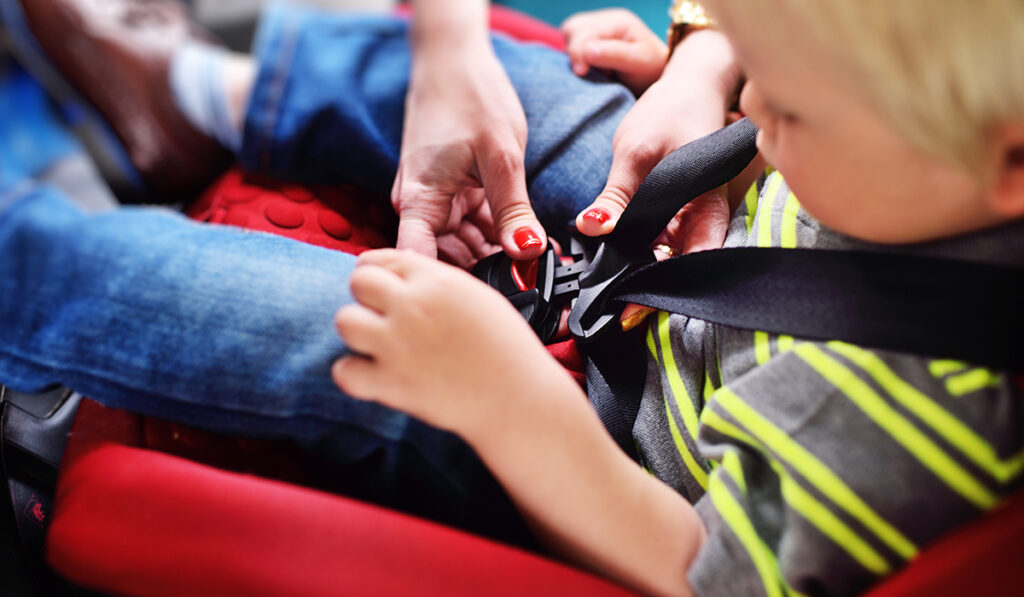There is no denying that seatbelts save lives, but thoracolumbar spine injury from deceleration is a potential result when children are involved in motor vehicle collisions.
While many seatbelt-injury cases involve intra-abdominal as well as spinal injuries, the internal damages are less likely to be detected during initial examinations.
Craig Louer, M.D., a pediatric orthopedic surgeon at Monroe Carell Jr. Children’s Hospital at Vanderbilt, worked with colleagues from general surgery to test whether the thoracolumbar injury classification and severity score (TLICS) is a reliable predictor of intra-abdominal injury and to pinpoint the level of risk-increase between each point on the 14 point scale.
“This work is identifying at which point clinicians can order these tests with confidence, knowing the probability of intra-abdominal injuries is substantial.”
“The index of suspicion must be high to justify the time, cost and radiation burden of a CT scan that captures these injuries, as well as the spine injuries,” Louer said. “This work is identifying at which point clinicians can order these tests with confidence, knowing the probability of intra-abdominal injuries is substantial.”
Their study outcomes were recently published in the Journal of the Pediatric Orthopaedic Society of North America.
Easy to Miss
For patients seen at Monroe Carell, intra-abdominal injuries are concurrent with about half of thoracolumbar injuries. In a slight majority of these cases, the child requires an operative intervention for the intra-abdominal injury. But these injuries remain easy to miss.
“They are often overlooked because of a distracting spine injury, so you have to use extra scrutiny.”
“They are often overlooked because of a distracting spine injury, so you have to use extra scrutiny,” Louer said. “On top of that, it’s often challenging to find the appropriate diagnostic tests for these abdominal injuries. It can take serial exams and even repeat imaging to find them. Ordering imaging that focuses just on the spine can lead to missing injuries like a bowel rupture or bleed.”
Timing Matters
Louer says in about 70 percent of the cases, the injuries do not involve neurologic deficits which require urgent surgical intervention.
For this majority, the timing of surgery or discharge relative to a clearance for intra-abdominal injuries is important. If a spine injury is not emergent but requires surgery, failing to address these injuries before proceeding with the operation can be complicating or catastrophic.
“It adds another physiologic insult to the child and compromises the likelihood of an optimal result for the spine surgery as well,” Louer said.
In cases where spine surgery is not needed, the patient might be sent home without knowing there is an additional injury.
“The hollow viscous injuries in particular are concerning from an infection and inflammation standpoint. If they aren’t recognized and treated, patients can get really, really sick,” he said. “Recognition is the key to treatment.”
New Use for the TLICS
To determine severity of a spine injury, clinicians routinely use the TLICS morphologic classification system that incorporates imaging features and clinical findings to make a diagnosis.
“We thought it made sense that the severity of the child’s spine injury would be an indicator of how likely they are to have an intra-abdominal injury.”
The retrospective study included 72 pediatric patients who had a spine injury from a motor vehicle collision. Nearly half of them had an intra-abdominal injuries to the bowels, liver, spleen, kidneys, and abdominal vasculature. Sixty-one percent of the patients needed an operative intervention for those injuries.
“We thought it made sense that the severity of the child’s spine injury would be an indicator of how likely they are to have an intra-abdominal injury.”
The researchers applied the TLICS scores to all 72 children. As hypothesized, a higher TLICS score was associated with an increased risk of concomitant intra-abdominal injury. Specifically, for every point increase in the TLICS, the risk of intra-abdominal injury increased 49 percent, and 79 percent of the patients with an intra-abdominal injury had a TLICS value at or above five.
Moving Forward with Confidence
Louer says these results are intended to guide trainees, residents and others who see a patient in the ED to think beyond the spine.
“We’re not going to order additional testing or admit someone to the hospital based on a hunch,” Louer said. “At the same time, we orthopaedic surgeons need to know that we’ve ruled out intra-abdominal injury when we are planning a spine surgery.”
At Monroe Carell, they found no study cases where an intra-abdominal injury was missed, but Louer says the Nashville hospital has a very low threshold to obtain a CT scan due, in part, to its adoption of low dose radiation protocols.
“Not everyone does this, and some hospitals don’t have any kind of CT machines readily available,” he said. “If they do, they can modify the imaging parameters to have a look at the rest of the abdomen as well as the spine. But that takes being tuned-in to the risk. If they know the patient has a high TLICS score, they can move forward with these exploratory searches more confidently.”






